
- Home
- History
- Maintenance
- Modifications
- Gallery
Spark Plug Replacement
Parts Needed
6 Toyota OEM Spark Plugs
Tools/Supplies Needed
Metric Socket Set
Various Extensions including a 12" Extension
Philips Head Screw Driver
5/8" Spark Plug Socket
Anti-seize
Dielectric grease
Toothbrush
Summary
Like changing your oil, changing your spark plugs is a basic maintenance task that every 4Runner owner should know. Fortunately for us, 5 of the 6 spark plugs are easy to change. I'll get to that later on in the writeup. A few common hand tools, some basic cleaning supplies and some speciality supplies is all you need to accomplish this important maintenance task.
A note on spark plug gap: the stock Toyota dual electrode spark plugs are pre-gapped at 0.044" from the factory. If one of the electrodes are closer to the center than the other, ask for another spark plug. If you should use it, you will suffer from an engine pulsing effect.
Step 1: Removing the Air Intake System
Removing the air intake system will allow you to easily access, clean and install the passenger side spark plugs. Begin by removing the 10mm three bolts that hold down the air box. Notice that not all of the bolts are the same type. From there, work your way up and disconnect the harness to the MAF adn the hose running to the intake silencer chamber. Working your way up further, loosen the two philips head screws on the wire clamps. Near the top, remove the tube near the top of the air intake tube and the air intake. Finally, shake off the air intake top at the top and gently remove the entire system from your 4runner.
It is possible (and easier) to just remove the air intake tube, but I removed the entire system so I could clean the air intake box.
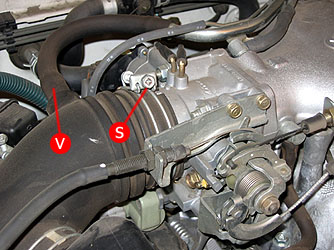
Pull out vaccuum tube (V) and unscrew screw (S)
Step 2: Removing the Coil Packs and Spark Plugs
Unlike older vehicles that uses a distributor-type electrical system, 3rd generation 4Runners use coil packs. Begin by taking your toothbrush and dry brushing off any dirt that accumulated around the outside of the coil packs and on the valve cover. Next unhook the harnesses that are attached to the coil packs. Finally unbolt the 10mm coil pack bolts and lift out all the coil packs. Alternatively, you can remove and work on one spark plug at a time.
At this point, I like to clean off any residual dirt on the valve cover so as to not allow any dirt to fall into the spark plug cylinder. Spray a little Simple Green on a cloth and, starting at the top of each hole, gently wipe the dirt off the outside perimeter. Next, attach your spark plug socket onto your extended rachet and gently unscrew and lift the spark plug out. Repeat for all three spark plugs.

Remove harnesses (H) and bolts (B) to remove the coil packs. But remember to brush off any loose dirt around the coil packs first.
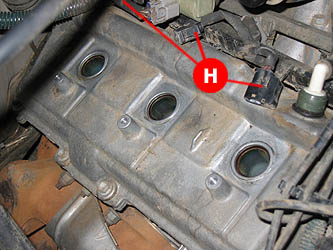
Harnesses (H) can be seen. Also, notice clean areas around the spark plug cylinders.
Step 3: Installing the Spark Plugs
It's important to prepare for the future ease of removal by using some dielectric grease and anti-seize on the spark plug boots and the spark plug threads. Begin by dabbing on the outside of the thread of the spark plug. Coat the spark plug threads with just enough grease to cover the threads. You don't have to coat all of the threads...just enough. Insert the plug into the spark plug socket and then tighten the spark plug down being careful not to overtorque. I follow the "When you feel a little tightness, turn it an additional 1/4 turn" rule.
After installing the plug, clean the bottom of coil pack boot with your Simple Green'd cloth and then put a bead of dielectric grease on the rubber boot surface. Reinstall the coil pack, refasten the bolt and fasten the coil pack harness. Repeat for the other two coil packs and spark plugs. Finish by reinstalling the air intake system and fastening all the screws, hoses and bolts.
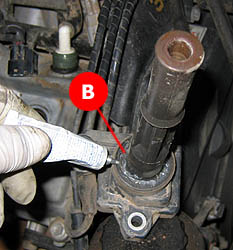
Put some dielectric grease on the underside of the coil pack's boot covers.
Step 4: Driver's Side Parts Removal
The driver's side spark plugs are a bit more difficult to remove because of the parts and hoses that are in the way. Additionally, the spark plug that is closest to the firewall is one helluva tight space to get your to do some work. Begin by unbolting the OBDII sensor's bolt, unplugging evaporator box hose, and optionally, the support bar that connects the engine block to the plenum. Unclip or remove any hoses that obstructs your ability to work in this tight space as well.
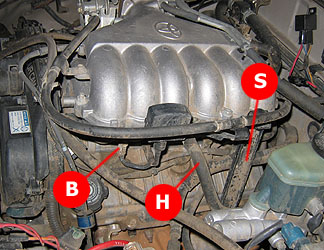
Remove bolt (B), hose (H) and support bar (S) for easier access to the spark plugs. Note: S is held in place by two bolts.
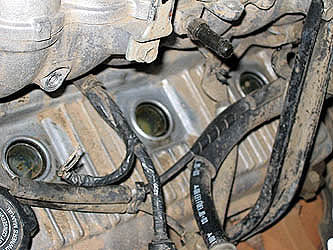
Spark plugs removed. Space is tight, but make sure that no dirt falls into the open holes!
Step 5: Installing Spark Plugs
Let's deal with the front-most and middle spark plugs first as they are the easiest. Begin by dry brushing any dirt off and around the spark plug boot. Next, lift off the spark plug boot off with your fingers. If there is some resistance, most likely it is the suction effect or a sticky rubber boot-to-metal contact. This is why you use dielectric grease on the boot! It makes it almost effortless to remove the boots in the future.
Next, repeat the procedures in Step 3 (disregarding the instructions related to the coil packs). As with the passenger side plugs, make sure to put anti-seize on the spark plug threads and dielectric grease on boots.
As for the plug closes to the firewall, this is a pain in the ass. The best way I've found to access this plug is reaching around the vertical center support bar. My hands are just small enough to reach around this bar and remove the boot.
Now if your hands are too big, remove this bar by removing the two 10mm bolts located at the top and bottom of the bar. It's best to just loosen the bottom bolt, so you can swivel it out of the way. Now you should have no problem cleaning, removing and reinstalling the bolts.
Finish up by reinstalling all the hoses and bolting on any parts you removed during the process and fire it up. If you've lost your brakes or jerking in first gear, check your hoses again---you missed reinstalling one of them. Otherwise, enjoy the the new plugs and a smoother ride.